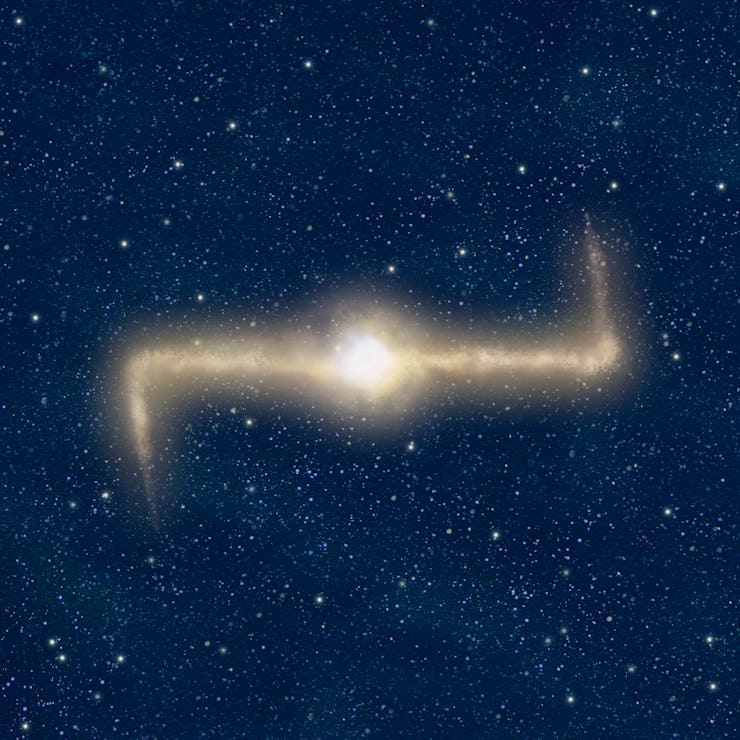How do galaxies get their shape? The science of key Webb Telescope targets, explained
There are many types of galaxies. But their shape depends on formation history.

Galaxies are collections of stars, gas, dust, and dark matter throughout the universe. Their size and scale can vary considerably. The Milky Way in which we live has 200 billion stars, which puts it about midway on the scale between the very largest galaxies and smaller types, like dwarf galaxies.
Like humans, these galaxies are shaped by their environment, which explains the different shapes we see, Karen Masters says. She is a Haverford College astrophysicist and the project scientist at Galaxy Zoo, a citizen science project that classifies different galaxy types.
“There’s a lot of variety out there in the universe,” Masters tells Inverse. Spiral galaxies have a circular shape like a Blu-Ray, while elliptical galaxies look something like an American pigskin football. Dwarf galaxies, which are far less massive than spirals or ellipticals, tend to be a lot more irregular, she says.
A pivotal step to thinking about galaxy shapes is understanding how they fit into the environment around them. To Masters, these galaxies are kind of like building blocks. “I sometimes think of them as like the fairy lights lighting up the branches of the tree, where the branches are kind of the underlying infrastructure that we have,” she says.
The infrastructure she refers to is dark matter, which is concentrations of mass that are invisible to the telescopes we use.
We can, however, infer the presence of dark matter due to the gravitational effects it produces on the matter that we can see. One common effect dark matter produces is light distortion, as NASA’s Jet Propulsion Laboratory explained on a web page.
“As the light from distant galaxies travels to us, it must pass through the gravitational fields of other galaxies. Hence, we see distorted images of the distant galaxies,” JPL stated. “Ordinary matter does not account for the amount of distortion that astronomers observe.”
The three main types of galaxies — with many dwarf galaxies belonging to irregular.
Galaxies have vast concentrations of dark matter that also causes them to be gravitationally attracted to each other, Masters says. “There will be galaxies gobbling up small galaxies,” she says, citing the Milky Way’s long history as an example. The Milky Way is also on an eventual collision course with a large neighbor, the Andromeda Galaxy.
Another important element to a galaxy’s shape is when they were formed. When the universe was smaller, and at an earlier stage of expansion following the Big Bang, mergers were much more common since galaxies were brought into interaction more frequently, Masters says. Gas was also quite abundant in these younger galaxies, leading to more possible materials that galaxies could use during these mergers.
These days, some 13.8 billion years after the universe was formed, most galaxies are changing more slowly. Internal changes lead to structures such as bar shapes occurring. Mergers still happen, however, albeit less frequently than before.
The orbits of stars can also influence the shape of a galaxy through various “density waves,” which occur as material gets compacted in galaxies in something equivalent to a traffic jam, Masters says. That’s because the orbits do not happen regularly, and stars might jam up together due to their mutual gravities influencing each other.
Conversely, supermassive black holes embedded in many galaxies’ centers don’t appear to have a significant effect on how a galaxy is shaped, since the black holes are so small relative to a galaxy’s mass, Masters adds.
Since galaxies have so many different varieties of shape within the big three (elliptical, spiral, and dwarf), Masters says Galaxy Zoo continues to be important in assisting with the classification of these various types. While machine learning is making computers more adept in picking out galaxy types, human intervention is good for putting the findings in the big picture.
As observatories like the James Webb Space Telescope accrue observations, Masters says, the numbers and types of galaxies we see will only increase. The community, she added, is very excited about the high-resolution views of early galaxies that Webb will provide when it completes commissioning this summer.